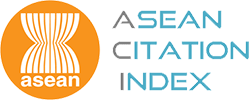การหาสภาวะที่เหมาะสมในการผลิตเอนไซม์ไลเปสจาก Bacillus safensis สายพันธุ์ PSR5631 ที่แยกได้จากดิน Optimization of lipase production by Bacillus safensis strain PSR5631 isolated from soil
Keywords:
เอนไซม์ไลเปส, สภาวะที่เหมาะสม, lipase, Bacillus safensis, optimizationAbstract
บทคัดย่อ เอนไซม์ไลเปสเป็นเอนไซม์ที่มีความสำคัญในกระบวนการเทคโนโลยีชีวภาพ เนื่องจากสามารถใช้เอนไซม์ไลเปส เป็นตัวเร่งทางชีวภาพซึ่งทำให้ปฏิกิริยาเกิดขึ้นในสภาวะที่ไม่รุนแรงได้ ในปัจจุบันเอนไซม์ไลเปสที่ผลิตจากแบคทีเรียนั้น เริ่มได้รับความสนใจมากขึ้น เพราะสามารถใช้ในกระบวนการรีพอลิเมอไรเซชันพลาสติกชีวภาพ เช่น พอลิ(แอล-แลกไทด์) ได้ งานวิจัยในครั้งนี้ได้ทำการคัดแยกแบคทีเรียที่สามารถผลิตเอนไซม์ไลเปสจากดินที่มีการปนเปื้อนของไขมัน บริเวณภาคใต้ของประเทศไทยและทำการศึกษาองค์ประกอบของอาหารเลี้ยงเชื้อที่เหมาะสมในการผลิตเอนไซม์ไลเปส โดยทำการเก็บตัวอย่างดิน 100 ตัวอย่าง มาคัดแยกบน Tween 80 agar แล้วสังเกตโซนขุ่นรอบโคโลนี ซึ่งจากผลการทดลองพบว่าสามารถคัดแยกแบคทีเรียได้ 662 ไอโซเลท โดยที่ไอโซเลท PSR5631 มีกิจกรรมของเอนไซม์ไลเปสมากที่สุดทั้งในอาหารแข็งและอาหารเหลว ดังนั้นจึงนำไอโซเลท PSR5631 มาวิเคราะห์สายพันธุ์โดยหาลำดับเบสบริเวณ 16S rRNA พบว่ามีความคล้ายคลึงกับเชื้อ Bacillus safensis เท่ากับ 99.6% similarity หลังจากนั้นนำไอโซเลท PSR5631 มาศึกษาปัจจัยที่ส่งผลต่อการผลิตเอนไซม์ไลเปส เช่น แหล่งคาร์บอนและแหล่งไนโตรเจน pH อุณหภูมิ และระยะเวลา ในการเลี้ยงเชื้อ โดยจากการศึกษาพบว่า สายพันธุ์ PSR5631 สามารถผลิตเอนไซม์ไลเปสได้สูงสุดคือ 68.60 U/mL ซึ่งในอาหารเลี้ยงเชื้อประกอบด้วย น้ำมันรำข้าว ความเข้มข้น 1.5% (v/v) ยีสต์สกัด ความเข้มข้น 0.32% (w/v) โซเดียมคลอไรด์ ความเข้มข้น 0.16% (v/w) pH 7.0 ที่ 37 องศาเซลเซียส นาน 60 ชั่วโมง การศึกษาในครั้งนี้พบว่าแบคทีเรียที่คัดแยกได้นั้น สามารถผลิตเอนไซม์ไลเปสได้ในปริมาณสูง ซึ่งสามารถนำไปประยุกต์ใช้ในด้านต่างๆต่อไป คำสำคัญ : Bacillus safensis เอนไซม์ไลเปส สภาวะที่เหมาะสม ABSTRACT Lipase is one of the important enzymes for the use in biotechnological processes. Lipase is a biocatalyst which is active at mild condition. Recently, bacterial lipase has become very interesting because it can be used for re-polymerization of biodegradable plastics such as poly(L-lactide). The present work aimed to screen lipase-producing bacteria from oil-contaminated soil in the South of Thailand and the optimization of medium composition for lipase-production has also studied. Lipase-producing bacteria with 662 strains were isolated from 100 soil samples according to opaque zone formation on Tween 80 agar. Bacteria strain PSR5631 exhibited the highest lipase activities in both agar plate and production medium. It was identified as Bacillus safensis strain PSR5631 based on 16S rRNA gene sequencing. Moreover, factors influencing lipase production were investigated in shake flask culture, i.e. carbon and nitrogen sources, pH, temperature and incubation time. The maximum enzyme activity of 68.60 U/mL was obtained by using 1.5% (w/v) rice bran oil and 0.32 % (w/v) yeast extract as carbon and nitrogen sources, respectively and using 0.16% (w/v) sodium chloride at pH 7, 37°C and 60 h cultivation. This study showed that a high lipase production could be found from bacterial isolate and can be used for further applications. Keyword: lipase, Bacillus safensis; optimizationDownloads
Download data is not yet available.
Downloads
How to Cite
กระจ่างสังข์ ส., พิกุลขวัญ ภ., พริ้งศุลกะ อ., สุวรรณาศรัย ณ., หล่อเหลี่ยม ว., ศรวณียารักษ์ ส., & กิจปรีชาวนิช ว. (2016). การหาสภาวะที่เหมาะสมในการผลิตเอนไซม์ไลเปสจาก Bacillus safensis สายพันธุ์ PSR5631 ที่แยกได้จากดิน Optimization of lipase production by Bacillus safensis strain PSR5631 isolated from soil. Science Essence Journal, 32(1), 115–130. Retrieved from https://ejournals.swu.ac.th/index.php/sej/article/view/7591
Issue
Section
Research Article








